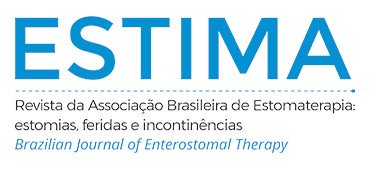EFFECT OF TELENURSING ON THE ADAPTIVE PROCESS OF PEOPLE WITH INTESTINAL STOMA: CLINICAL TRIAL
Abstract
Objective: To analyze the effect of telenursing on the adaptive process of people with intestinal ostomy. Method: Randomized, single-blind clinical trial. The verification scale of the level of adaptation of the person with ostomy was applied, and two groups were formed. The control group received conventional care with professionals from the reference center, and the intervention group received conventional follow-up associated with the complementary intervention via telephone (three phone calls on the 20th, 40th and 60th day after initial contact). At the end of the intervention, the participants were evaluated again through the scale. Recruitment occurred from the first contact and had a sample of 16 participants in the intervention group and 17 in the control group. Results: There was a similarity in the levels of adaptation at baseline between the two groups. However, post-intervention data showed a significant difference between the groups during the study and lower values of the means of the control group compared to the measures of the intervention group, demonstrating a higher level of adaptation in the intervention group. Conclusion: The study verified the effect of telenursing on the adaptive process of the person with a stoma and suggests benefits in complementary monitoring via telenursing at the level of adaptation of people with a stoma after ≤ 12 months of surgery.
Downloads
Metrics
References
Ganjalikhani MK, Tirgari B, Rashtabadi OR, Shahesmaeili A. Studying the effect of structured ostomy care training on quality of life and anxiety of patients with permanent ostomy. Int Wound J. 2019;16(6):1383-90. https://doi.org/10.1111/iwj.13201
Silva AL, Vieira ABD, Moraes RHG, Mazoni SR, Kamada I. Subjectivities and challenges of people living with an intestinal ostomy. ESTIMA, Braz. J. Enterostomal Ther. 2021;19:e1721. https://doi.org/10.30886/estima.v19.1034_IN
Roy C, Andrews HA. Teoria da enfermagem: o modelo de adaptação de Roy. Piaget; 2001.
Marques ADB, Amorim RF, Landim FLP, Moreira TMM, Branco JGO, Morais PB, Santos ZMSA. Body consciousness of people with intestinal stomach: A phenomenological study. Rev Bras Enferm. 2018;71(2):391-7. https://doi.org/10.1590/0034-7167-2016-0666
Sun V, Ercolano E, Mccorkle R, Grant M, Wendel CS, Tallman NJ, et al. Ostomy telehealth for cancer survivors: Design of the ostomy self-management training (OSMT) randomized trial. Contemp Clin Trials. 2018;64:167-72. https://doi.org/10.1016/j.cct.2017.10.008
Cofen. Decreto no 696/2022. Dispõe sobre a atuação da Enfermagem na Saúde Digital, normatizando a Telenfermagem. Cofen;2022.
Kristová J, Bachratá Z, Slezáková Z, Miklovičová E. Implementation of telenursing in the Slovak Republic. Pielęgniarstwo XXI Wieku. 2021;20(3):216-20. https://doi.org/10.2478/pielxxiw-2021-0028
Santana RF, Pereira SK, Carmo TGD, Freire VECDS, Soares TDS, Amaral DMD, Vaqueiro RD. Effectiveness of a telephone follow-up nursing intervention in postsurgical patients. Int J Nurs Pract .2018;24(4):e12648. https://doi.org/10.1111/ijn.12648
França AC, Rodrigues AB, Aguiar MIF, Silva RA, Freitas FMC, Melo GAA. Telenursing for the control of chemotherapy-induced nausea and vomiting: a randomized clinical trial. Texto Contexto Enferm. 2019;28:e20180404. https://doi.org/10.1590/1980-265x-tce-2018-0404
Jiménez PQ, Juan CP, Herrero IP, López CP, Fuentes MG, Casaseca CM, Romaguera AR, Valentí MT, Garcia-Alamino JM, Espirac B, Grupo Cooperativo Estudio Calidad de Vida. A prospective, longitudinal, multicenter, cohort quality-of-life evaluation of an intensive follow-up program for patients with a stoma. Ostomy Wound Manage. 2010;56(5):44-52.
Xavier SSM. Validação da escala de verificação do nível de adaptação da pessoa com estomia (ENAE) elaborada à luz do modelo de Roy [tese de doutorado online]. Natal: Universidade Federal do Rio Grande do Norte; 2018 [acessado em 16 jan. 2023]. Disponível em: https://repositorio.ufrn.br/jspui/handle/123456789/25468
Medeiros LP, Xavier SSM, Freitas LS, Silva IP, Brito do O L, Lucena SKP, Silva RA, Costa IKF. Construction and validity of the adaptation level scale of the person with ostomy. ESTIMA, Braz. J. Enterostomal Ther. 2022;16:e0822. https://doi.org/10.30886/estima.v20.1191_IN
Reis BL, Brandão ES, Tonole R, Moraes EB. Difficulties presented by people with intestinal stoma during self-care: integrative review. Res Soc Dev. 2020;9(11):e55891110183. https://doi.org/10.33448/rsd-v9i11.10183
Ribeiro WA, Andrade M. Perspectiva do paciente estomizado intestinal frente a implementação do autocuidado. Rev Pró-UniverSUS. 2020;11(1):6-13. https://doi.org/10.21727/rpu.v11i1.2214
Selau CM, Limberger LB, Silva MEN, Pereira AD, Oliveira FS, Margutti KMM. Perception of patients with intestinal ostomy in relation to nutritional and lifestyle changes. Texto Contexto Enferm. 2019;28:e20180156. https://doi.org/10.1590/1980-265X-TCE-2018-0156
Valau Júnior CAD, Simon BS, Garcia RP, Dalmolin A, Stamm B, Harter J. Perfil sociodemográfico e práticas de autocuidado desenvolvidas por pessoas com estomia intestinal de eliminação. Braz J Develop. 2020;6(6):41030-47. https://doi.org/10.34117/bjdv6n6-588
Sasaki VDM, Teles AAS, Silva NM, Russo TMS, Pantoni LA, Aguiar JC, Sonobe HM. Self-care of people with intestinal ostomy: beyond the procedural towards rehabilitation. Rev Bras Enferm. 2021;74(1):e20200088. https://doi.org/10.1590/0034-7167-2020-0088
Diniz IV, Alves KL, Sá CM, Almeida AM, Silva RA, Soares SHO, Soares MJGO. Adaptive responses of colostomy patients before and after using an occlude. Acta Paul Enferm. 2022;35:eAPE01917. https://doi.org/10.37689/acta-ape/2022AO019177
Hoppe ADS, Paczek RS, Pagliarini AM, Tanaka AKNSDR, Micheletti VCD, Lana LD. Irrigação de colostomia: impacto na qualidade de vida. Saúde Coletiva. 2021;11(69):8286-95. https://doi.org/10.36489/saudecoletiva.2021v11i69p8286-8295
Santos FS, Vicente NG, Bracarense CF, Dal-Poggeto MT, Goulart BF, Rodrigues LR. Perception of spouses of people with intestinal ostomy on the sexuality of the couple. REME Rev Min Enferm. 2019;23:e-1217. https://doi.org/10.5935/1415-2762.20190065
Santos LCA, Ribeiro WA, Oliveira CR, Guedes CM, Teixeira JM, Cirino HP, Morais MC, Castro K. The person with intestinal ostomy and the return to work activities: a reflective study from the perspective of worker health. Res Soc Dev. 2022;11(11):e158111133541.https://doi.org/10.33448/rsd-v11i11.33541
Ribeiro WA, Andrade M, Fassarella BPA, Flach DMAM, Teixeira JM, Renauro KCDSS. Patients’ profile of the stomized person health care nucleus: in sociocultural and economic optics. Rev Nursing. 2019;22(251):2868-74. https://doi.org/10.36489/nursing.2019v22i251p2868-2874
Lira JAC, Bezerra SMG, Oliveira AC, Rocha DM, Silva JS, Nogueira LT. Collection and adjuvant equipment costs in patients with elimination ostomy. REME Rev Min Enferm. 2019;23:e-1163. https://doi.org/10.5935/1415-2762.20190011
Byfield D. The lived experiences of persons with ostomies attending a support group: a qualitative study. J Wound Ostomy Continence Nurs. 2020;47(5):489-95. https://doi.org/10.1097/WON.0000000000000696
Downloads
Published
Versions
- 2023-09-05 (2)
- 2023-08-30 (1)
How to Cite
Issue
Section
License
Copyright (c) 2023 Luana Souza Freitas, Isabelle Pereira da Silva, Julliana Fernandes de Sena, Lorena Brito do O', Breno Wagner Araújo Cosme da Silva, Iraktania Vitorino Diniz, Vera Lúcia Conceição de Gouveia Santos, Isabelle Katherinne Fernandes Costa

This work is licensed under a Creative Commons Attribution 4.0 International License.

























